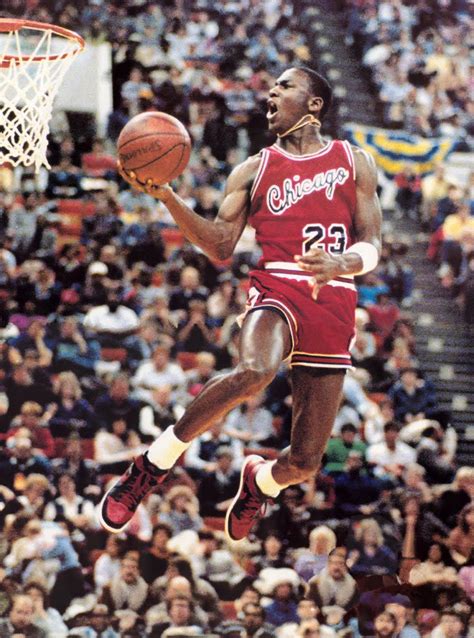
Michael Jordan, known for his intense competitiveness, reportedly banned Air Jordans from the Chicago Bulls’ locker room during the 1980s and 90s, according to former teammate B.J. Armstrong, fostering a culture of focus and preventing players from becoming complacent.
B.J. Armstrong, a former teammate of Michael Jordan, has revealed that the basketball legend prohibited the wearing of Air Jordans in the Chicago Bulls’ locker room. Armstrong shared this anecdote during an appearance on the “Gimme the Hot Sauce” podcast, shedding light on Jordan’s relentless drive and leadership style. The rule, according to Armstrong, was implemented to keep players hungry and prevent them from becoming complacent with their success.
“There was a rule, and I loved it, but there was a rule: You could not wear Air Jordans in the locker room,” Armstrong stated. “Never ever allowed. We’re not a Jordan team. We’re a team. And he understood that.”
This seemingly unusual regulation highlights Jordan’s understanding of team dynamics and his strategic approach to maintaining a competitive edge. The rule was intended to emphasize the collective identity of the Bulls, preventing any individual from overshadowing the team’s goals. Jordan, despite being the face of the Air Jordan brand, recognized the potential for division and the importance of unity within the locker room.
The ban, as Armstrong suggests, wasn’t about ego or control but about fostering a team-first mentality. By preventing players from showcasing the coveted sneakers, Jordan aimed to level the playing field and ensure that everyone remained focused on the shared objective: winning championships. This insight provides a glimpse into the meticulous strategies Jordan employed to cultivate a winning environment.
The 1990s Chicago Bulls are renowned as one of the greatest dynasties in NBA history. Led by Michael Jordan, alongside other prominent players such as Scottie Pippen and Dennis Rodman, the Bulls achieved unprecedented success, securing six NBA championships in eight years. Their dominance was characterized not only by exceptional talent but also by a deep-seated culture of discipline, teamwork, and unwavering commitment. Jordan’s leadership was instrumental in shaping this culture, and his influence extended beyond the court, permeating every aspect of the team’s operations.
Armstrong’s revelation underscores the importance of leadership in building a championship-caliber team. Jordan’s ban on Air Jordans in the locker room, though unconventional, was a deliberate attempt to reinforce team unity and maintain a competitive mindset. By setting this example, Jordan instilled a sense of collective responsibility and prevented complacency from creeping into the Bulls’ locker room.
The rule reflects Jordan’s understanding that success is not solely determined by individual brilliance but also by the ability of a team to function cohesively. He recognized that fostering a team-first mentality was essential for achieving sustained success. The anecdote shared by Armstrong demonstrates that Jordan’s leadership was not limited to his on-court performance but extended to creating a supportive and focused environment for his teammates.
The Air Jordan brand, a subsidiary of Nike, has become a global phenomenon, transcending the boundaries of sports and fashion. Since its inception in 1984, the brand has released numerous iconic sneaker models, each bearing the signature style and branding of Michael Jordan. The Air Jordan line has not only generated billions of dollars in revenue for Nike but has also become a symbol of status, style, and athletic excellence.
Given the immense popularity and cultural significance of Air Jordans, Jordan’s decision to ban them from the Bulls’ locker room is even more striking. It highlights his willingness to prioritize team success over personal branding and marketing opportunities. The ban demonstrates that Jordan was willing to make unconventional choices to ensure that the Bulls remained focused on their ultimate goal: winning championships.
Armstrong’s comments offer a unique perspective on the inner workings of the Chicago Bulls dynasty and the leadership of Michael Jordan. The ban on Air Jordans in the locker room may seem like a small detail, but it reflects Jordan’s strategic mindset and his unwavering commitment to team success. This anecdote serves as a reminder that leadership is not only about individual talent but also about creating a culture of discipline, teamwork, and unwavering focus.
The impact of Michael Jordan on the game of basketball is immeasurable. His accomplishments, accolades, and iconic moments have solidified his status as one of the greatest players of all time. Jordan’s influence extends beyond his on-court performance, as he has also become a global icon and a role model for athletes around the world. His leadership, competitiveness, and unwavering determination have inspired generations of basketball players and fans.
The story of the Air Jordan ban in the Bulls’ locker room adds another layer to the legend of Michael Jordan. It demonstrates his willingness to make difficult decisions and challenge conventional wisdom in pursuit of team success. This anecdote serves as a testament to Jordan’s leadership and his understanding of the importance of team unity.
The Chicago Bulls’ dynasty of the 1990s remains a source of fascination for basketball fans. The team’s dominance, led by Michael Jordan, is a testament to the power of talent, teamwork, and leadership. Armstrong’s revelation about the Air Jordan ban provides a unique glimpse into the inner workings of this iconic team and the strategies employed by Jordan to cultivate a winning environment.
In conclusion, B.J. Armstrong’s revelation about Michael Jordan’s ban on Air Jordans in the Chicago Bulls’ locker room sheds light on Jordan’s leadership style and his commitment to team success. The ban, though unconventional, reflects Jordan’s understanding of team dynamics and his strategic approach to maintaining a competitive edge. This anecdote serves as a reminder that leadership is not only about individual talent but also about creating a culture of discipline, teamwork, and unwavering focus. The legacy of Michael Jordan and the Chicago Bulls dynasty continues to inspire basketball fans around the world, and stories like this one provide valuable insights into the inner workings of one of the greatest teams in NBA history.
The ban wasn’t about stifling individual expression; it was about fostering a collective identity. By preventing players from showcasing the coveted sneakers, Jordan aimed to level the playing field and ensure that everyone remained focused on the shared objective: winning championships. This subtle yet powerful tactic underscored Jordan’s belief in the power of unity and his willingness to sacrifice individual recognition for the greater good of the team.
Furthermore, the rule served as a constant reminder that they were there to work. The locker room was not a place for flaunting wealth or status but a sanctuary for preparation and focus. Jordan understood that complacency could be a team’s worst enemy, and he was determined to prevent it from taking root. By banning Air Jordans, he sent a clear message that success was not guaranteed and that hard work and dedication were essential for maintaining their championship caliber.
The impact of this seemingly simple rule extended beyond the locker room. It permeated the team’s culture, fostering a sense of humility and camaraderie. Players were less likely to get caught up in individual accolades and more likely to focus on supporting each other. This shared sense of purpose helped to create a cohesive and resilient unit, capable of overcoming challenges and achieving remarkable feats.
In essence, the Air Jordan ban was a microcosm of Jordan’s leadership philosophy. He believed in leading by example, setting high standards, and demanding excellence from everyone around him. He understood that true success was not about individual glory but about collective achievement. By instilling these values in his teammates, he transformed the Chicago Bulls into a dynasty that would be remembered for generations to come.
The story also highlights the complex relationship between individual branding and team identity in professional sports. While athletes are often encouraged to cultivate their personal brands, it is important to strike a balance between individual recognition and team success. Jordan’s decision to ban Air Jordans in the locker room demonstrates his understanding of this delicate balance and his willingness to prioritize the team’s needs over his own personal brand.
This approach resonates even more profoundly in today’s era of hyper-individualism, where athletes are increasingly seen as brands rather than team members. Jordan’s leadership offers a valuable lesson in the importance of collective identity and the power of unity in achieving shared goals.
The anecdote also provides insights into the psychological dynamics of a high-performing team. The pressure to perform at the highest level can be immense, and it is essential to create an environment where players feel supported, focused, and motivated. Jordan’s ban on Air Jordans was a subtle but effective way of managing these psychological pressures and ensuring that everyone remained aligned with the team’s objectives.
By removing the distractions of individual branding, Jordan created a space where players could focus on their craft, develop their skills, and build strong relationships with their teammates. This sense of camaraderie and mutual support was essential for the Bulls’ success, as it allowed them to overcome adversity and maintain their competitive edge throughout the grueling NBA season.
Moreover, the story sheds light on the evolution of leadership styles in professional sports. In the past, leadership was often associated with authoritarian figures who relied on fear and intimidation to motivate their teams. However, Jordan’s approach was more nuanced and sophisticated. He understood the importance of inspiring his teammates, fostering a sense of ownership, and creating a culture of accountability.
By empowering his teammates and encouraging them to take responsibility for their performance, Jordan created a self-sustaining system of excellence. Players were not simply following orders; they were actively engaged in the process of building a championship-caliber team. This collaborative approach to leadership was a key factor in the Bulls’ success and helped to solidify Jordan’s legacy as one of the greatest leaders in sports history.
The lasting impact of Michael Jordan’s leadership extends far beyond the basketball court. His principles of teamwork, discipline, and relentless pursuit of excellence are applicable to any field, from business to education to personal development. By studying his leadership style and understanding the strategies he employed to build a championship-caliber team, individuals can gain valuable insights into how to achieve success in their own endeavors.
The Air Jordan ban in the Bulls’ locker room may seem like a minor detail, but it represents a profound lesson in leadership, teamwork, and the power of collective identity. It is a reminder that true success is not about individual glory but about the ability to inspire and empower others to achieve their full potential. As long as the story of Michael Jordan and the Chicago Bulls dynasty continues to be told, this lesson will continue to resonate with audiences around the world.
The anecdote also serves as a historical marker, illustrating how sports culture has evolved over time. In the 1990s, the emphasis on team unity and collective identity was arguably stronger than it is today. The rise of social media and individual branding has shifted the focus towards individual athletes and their personal brands.
While individual expression and marketing opportunities are certainly important, it is crucial to remember the value of teamwork and collective identity. Jordan’s ban on Air Jordans serves as a reminder that the success of a team depends on the ability of its members to work together, support each other, and prioritize the collective goal over individual recognition.
This lesson is particularly relevant in today’s interconnected world, where collaboration and teamwork are essential for solving complex problems and achieving ambitious goals. By embracing the principles of teamwork and collective identity, individuals and organizations can unlock their full potential and create lasting impact.
The story of the Air Jordan ban also prompts us to consider the role of discipline and structure in fostering a winning environment. While creativity and innovation are important, they must be balanced with a sense of discipline and a commitment to established processes. Jordan’s ban on Air Jordans was a way of enforcing discipline and ensuring that everyone adhered to the team’s standards.
This principle is applicable to any organization, whether it is a sports team, a business, or a non-profit. By establishing clear expectations, enforcing rules consistently, and holding individuals accountable for their actions, leaders can create a culture of discipline that fosters productivity and success.
Furthermore, the anecdote highlights the importance of adaptability in leadership. While Jordan was known for his unwavering commitment to his principles, he was also willing to adapt his approach as needed. The ban on Air Jordans was a strategic decision that was tailored to the specific circumstances of the Chicago Bulls team.
Leaders must be able to assess the unique challenges and opportunities facing their organizations and adapt their strategies accordingly. This requires a combination of vision, flexibility, and the ability to learn from experience. By embracing adaptability, leaders can ensure that their organizations remain competitive and resilient in the face of change.
The legacy of Michael Jordan and the Chicago Bulls dynasty continues to inspire athletes, coaches, and leaders around the world. Their story is a testament to the power of talent, teamwork, and leadership. By studying their success and understanding the principles that guided them, individuals can gain valuable insights into how to achieve their own goals and make a lasting impact.
The Air Jordan ban in the Bulls’ locker room may seem like a small detail, but it represents a profound lesson in leadership, teamwork, and the pursuit of excellence. It is a reminder that true success is not about individual glory but about the ability to inspire and empower others to achieve their full potential. As long as the story of Michael Jordan and the Chicago Bulls dynasty continues to be told, this lesson will continue to resonate with audiences around the world.
The ripple effect of Jordan’s leadership extends to modern team dynamics, where fostering unity remains paramount. Coaches and team leaders today often employ similar strategies, albeit with a modern twist, to ensure that individual ambitions align with collective goals. This story serves as a timeless reminder that the fundamentals of team building, such as discipline, focus, and mutual respect, transcend eras and continue to define successful sports organizations.
The narrative also underscores the significance of setting boundaries to maintain focus. In today’s world, filled with distractions and competing priorities, the ability to create a dedicated space for work and preparation is more crucial than ever. Jordan’s rule highlights the importance of minimizing external influences and creating an environment conducive to peak performance.
Moreover, the Air Jordan ban can be viewed as a form of psychological conditioning. By associating the locker room with work and preparation, Jordan reinforced the idea that it was a sacred space where distractions were not allowed. This subtle conditioning helped to create a mindset of focus and determination among the Bulls players.
In addition to the Air Jordan ban, Jordan implemented other strategies to cultivate a winning culture. He challenged his teammates to push themselves beyond their limits, held them accountable for their performance, and fostered a sense of competition within the team. These tactics helped to create an environment where players were constantly striving to improve and achieve their full potential.
Jordan’s relentless drive for excellence was contagious, and it inspired his teammates to raise their own standards. He demanded the best from everyone around him, and he was not afraid to call out players who were not pulling their weight. This demanding leadership style was not always easy to accept, but it ultimately helped the Bulls to achieve their championship goals.
The story of the Air Jordan ban serves as a reminder that leadership is not always about being popular or liked. Sometimes, it requires making difficult decisions and challenging conventional wisdom. Jordan was willing to do whatever it took to create a winning environment, even if it meant alienating some of his teammates.
The ban also had a practical purpose. By preventing players from wearing Air Jordans in the locker room, Jordan reduced the risk of them getting damaged or stolen. Air Jordans were highly coveted items, and they could easily become targets for theft or vandalism. By banning them from the locker room, Jordan protected his teammates’ investments and reduced the potential for conflict.
The rule wasn’t about the shoes themselves; it was about the message they conveyed. Wearing Air Jordans in the locker room could be interpreted as a sign of arrogance or complacency, and Jordan wanted to avoid sending that message to his teammates. He wanted everyone to understand that they were there to work hard, focus on their goals, and contribute to the team’s success.
The Air Jordan ban was a small but significant example of Jordan’s leadership style. It demonstrated his attention to detail, his strategic thinking, and his unwavering commitment to excellence. It is a reminder that true leadership is not just about making grand gestures; it is about paying attention to the small things that can make a big difference.
Frequently Asked Questions (FAQ)
1. Why did Michael Jordan ban Air Jordans from the Chicago Bulls’ locker room?
Michael Jordan banned Air Jordans to foster a team-first mentality, prevent complacency, and emphasize that the Bulls were a team, not just a collection of individuals showcasing personal brands. According to B.J. Armstrong, the rule was meant to keep players hungry and focused on winning championships rather than individual recognition. “We’re not a Jordan team. We’re a team. And he understood that,” Armstrong stated.
2. How did this ban contribute to the Chicago Bulls’ success during the 1990s?
The ban, while seemingly minor, contributed to a culture of unity and discipline. It reinforced the idea that the locker room was a place for preparation and focus, not for flaunting status or wealth. By minimizing distractions and emphasizing the collective goal, Jordan helped create a cohesive team capable of overcoming challenges and achieving remarkable success.
3. Was the ban related to ego or control, or was there another motive behind it?
According to B.J. Armstrong, the ban wasn’t about ego or control but about fostering a team-first environment. Jordan aimed to level the playing field and ensure everyone remained focused on the shared objective of winning championships. The intention was to promote humility and camaraderie, preventing players from getting caught up in individual accolades.
4. Did other players on the Chicago Bulls agree with the ban, or was there any resistance to it?
The article doesn’t explicitly state the reaction of all players. However, B.J. Armstrong “loved it,” suggesting he understood and appreciated the intent behind the rule. The lack of widespread reporting of discontent implies that, while potentially unconventional, the ban was generally accepted as part of Jordan’s leadership style and the team’s culture of discipline.
5. How does this anecdote reflect Michael Jordan’s overall leadership style?
The anecdote reflects Jordan’s strategic mindset, attention to detail, and unwavering commitment to excellence. It demonstrates his willingness to make unconventional choices to ensure team success, prioritizing collective achievement over individual branding. His leadership style emphasized leading by example, setting high standards, and demanding excellence from everyone around him.









